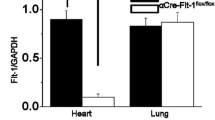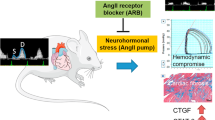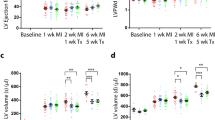Abstract
Hearts of normotensive angiotensin II type 2 receptor (AT2)-deficient mice do not develop fibrosis after angiotensin II-induced chronic hypertension. Thus, the goal of our study was to clarify whether AT2 knockouts (KOs) are also characterized by altered left ventricular (LV) function and modified remodeling of the extracellular matrix (ECM) after induction of myocardial infarction (MI). MI was induced in 5-mo-old female AT2-deficient mice and controls by occlusion of the left coronary artery. Time-matched sham-operated animals served as controls. After 48 h, the first sets of mice were hemodynamically characterized using a pressure-tip catheter (n=8/group). We also obtained pressure volume loops using a microconductance catheter in additional sets of animals 3 wk after induction of MI (n=7/group). Finally, the collagen index was illustrated by Sirius red staining and quantified by digital analysis. Whereas the LV function of sham-operated animals did not differ between both genotypes, the collagen index was 44% lower in KO animals. Forty-eight hours and 3 wk post-MI, systolic and diastolic LV function were impaired in both AT2-deficient and wild-type (WT) animals to the same extent by approx 45%. No differences were found between the two genotypes with respect to LV hypertrophy and the fibrosis index in the infarcted and noninfarcted areas 3 wk post-MI. While AT2-KO mice had less cardiac collagen content under basal conditions, the receptor deficiency had no significant influence on LV function at the two investigated time points after induction of MI or on the remodeling of ECM at the latter time point. Thus, hypetension-induced fibrosis is probably triggered by other control mechanisms than fibrosis induced by MI.
Similar content being viewed by others

References
Matsubara, H. (1998) Pathophysiological role of angiotensin II type 2 receptor in cardiovascular and renal diseases. Circ. Res. 83, 1182–1191.
Senbonmatsu, T., Ichihara, S., Price, E. Jr., et al. (2000) Evidence for angiotensin II type 2 receptor-mediated cardiac myocyte enlargement during in vivo pressure overload. J. Clin. Invest. 106, R25-R29.
Hein, L., Barsh, G. S., Pratt, R. E., Dzau, V. J., and Kobilka, B. K. (1995) Behavioural and cardiovascular effects of disrupting the angiotensin II type-2 receptor in mice [published erratum appears in Nature 1996;380:366]. Nature 377, 744–747.
Ichiki, T., Labosky, P. A., Shiota, C., et al. (1995) Effects on blood pressure and exploratory behavior on mice lacking angiotensin II type-2 receptors. Nature 377, 748–750.
Gross, V., Walther, T., Milia, A. F., Walter, K., Schneider, W., and Luft FC. (2001) Left ventricular function in mice lacking the AT2 receptor. J. Hypertens. 19, 967–976.
Ichihara, S., Senbonmatsu, T., Price, E., et al. (2001) Angitensin II type 2 receptor is essential for left ventricular hypertrophy and cardiac fibrosis in chronic angiotensin II-induced hypertension. Circulation 104, 346–351.
Nio, Y., Matsubara, H., Murasawa, S., et al. (1995) Regulation of gene transcription of angiotensin II receptor subtypes in myocardial infarction. J. Clin. Invest. 95, 46–54.
Adachi, Y., Saito, Y., Kishimoto, I., et al. (2003) Angiotensin II type 2 receptor deficiency exacerbates heart failure and reduces survival after acute myocardial infarction in mice. Circulation 107, 2406–2408.
Walther, T., Siems, W.-E., Hauke, D., et al. (2002) AT1 receptor blockade increases cardiac bradykinin via neutral endopeptidase after induction of myocardial infarction in rats. FASEB J. 16, 1237–1241.
Steendijk, P. and Baan, J. (2000) Comparison of intravenous and pulmonary artery injections of hypertonic saline for the assessment of conductance catheter parallel conductance. Cardiovasc. Res. 46, 82–89.
Pauschinger, M., Knopf, D., Petschauer, S., et al. (1999) Dilated cardiomyopathy is associated with significant changes in collagen type I/III ratio. Circulation 99, 2750–2756.
Matsubara, H. (1998) Pathophysiological role of angiotensin II type 2 receptor in cardiovascular and renal diseases. Circ. Res. 83, 1182–1191.
Kramer, C. M., Lima, JAC., Reichek, N., et al. (1993) Regional function within noninfarcted myocardium during left ventricular remodeling. Circulation 88, 1279–1288.
Yamazaki, T., Komuro, I., Kudoh, S., et al. (1995) Angiotensin II partly mediates mechanical stress-induced cardiac hypertrophy. Circ. Res. 77, 258–265.
Ohkubo, N., Matsubara, H., Nozawa, Y., et al. (1997) Angiotensin type 2 receptors are reexpressed by cardiac fibroblasts from failing myopathic hamster hearts and inhibit cell growth and fibrillar collagen metabolism. Circulation 96, 3954–3962.
Ichihara, S., Senbonmatsu, T., Price, E Jr., Ichiki, T., Gaffney, F. A., and Inagami, T. (2002) Targeted deletion of angiotensin II type 2 receptor caused cardiac rupture after acute myocardial infarction. Circulation 106, 2244–2249.
Xu, J., Carretero, O. A., Liu, Y. H., et al. (2002) Role of AT2 receptors in the cardioprotective effect of AT1 antagonists in mice. Hypertension 40, 244–250.
Walther, T., Klostermann, K., Heringer-Walther, S., Schultheiss, H.-P., Tschöpe, C., and Stepan, H. (2003) Fibrosis rather than blood pressure determines cardiac BNP expression in mice. Regul. Pept. 116, 95–100.
Yang, Z., Bove, C. M., French, B. A., et al. (2002) Angiotensin II type 2 receptor overexpression preserves left ventricular function after myocardial infarction. Circulation 106, 106–111.
Ross, A. H., Yang, Z., Berr, S. S., et al. (2002) Serial MRI evaluation of cardiac structure and function in mice after reperfused myocardial infarction. Magn. Reson. Med. 47, 1158–1168.
White, H. D., Norris, R. M., Brown, M. A., et al. (1987) Left ventricular end-systolic volume as the major determinant of survival after recovery from myocardial infarction. Circulation 76, 44–51.
Author information
Authors and Affiliations
Corresponding author
Rights and permissions
About this article
Cite this article
Tschöpe, C., Westermann, D., Dhayat, N. et al. Angiotensin AT2 receptor deficiency after myocardial infarction. Cell Biochem Biophys 43, 45–52 (2005). https://doi.org/10.1385/CBB:43:1:045
Issue Date:
DOI: https://doi.org/10.1385/CBB:43:1:045



